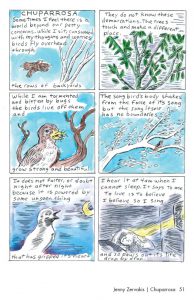Aaron Cockle with GG Comics; Aidan Koch Exhibiting; ELCAF Capsule Reviews; Susan Te Kahurangi King; Jason Shiga; Ink Brick 5; Hopper Process
—————————————————————————————————
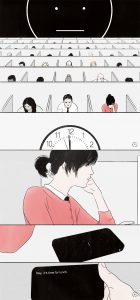
Unattainable by GG
CW’s featured comic for this week, from 2015. All of GG’s comics can be read for free on her website (completed stories) and on her tumblr (in progress stories).
—————————————————————————————————
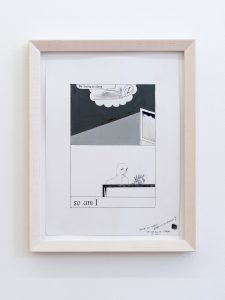
The person you are trying to reach is not available
Work by Aidan Koch & Ieva Kraule, at Hester Gallery in NYC, continues through July 3, 2016.
—————————————————————————————————
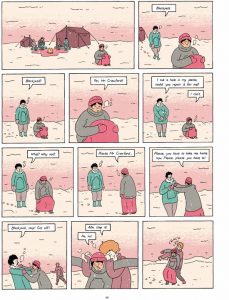
Some quick reviews of comics purchased at the recent East London Comic Arts Festival
[Luke] Healy’s storytelling is superb. The book begins with a double page from each story, context free, before we travel back to the beginning of each. Gradually, connections emerge and the beautiful colouring does nothing to stem the slowly dawning horror as the conditions worsen. As the members of the 1921 expedition find themselves stuck on a deserted island, with crossing hundreds of miles of sea ice the only hope of escape, the discovery of bear skulls and the threat of scurvy reveal just how indifferent the friendly arctic is to humans. There are numerous brilliantly understated details throughout, and the fact that we know Blackjack has a sick child at home makes her plight all the more awful. This is a book with a strongly compelling narrative – the expertly timed switches between the three stories encourage you to keep going – and I found myself reading the book in a single evening. The artwork is terrific, with really effective use of colour, and although the influence of Chris Ware can be seen in the characters it’s certainly not to the extent where it becomes derivative. Healy is a very talented storyteller and artist, and this is a strong release.
— via Pete Redrup
—————————————————————————————————
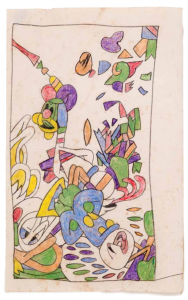
THERE IS NO CENTER: Dan Nadel on Susan Te Kahurangi King at Edlin Gallery
At first glance King’s drawings are unlikely candidates for the amount of press they’ve received, let alone a full-blown museum exhibition—we’re talking about small, cartoon-based pictures, all made using the same pencil-and-crayon techniques and often in scrappy condition. But compositionally, King’s pictures permit various points of entry, providing the viewer a license to interpret freely. We may recognize cartoon characters and humanoids, but the odd secret of icons like Woody Woodpecker, Bugs Bunny, and Daffy Duck is that, embedded as they are in our cultural memory, they read however we want them to—invested with historical meaning or as hollow masks, purely formal agglomerations of shapes.
— via Dan Nadel
—————————————————————————————————
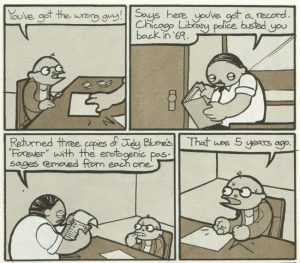
Jason Shiga Interviewed at TCJ
Why did you choose Risograph printing for this series? What is your process like?
I bought a Risograph printer because I wanted to do a two-color comic and it’s the cheapest option. I do also like the way it looks. It has that really warm, organic feel to it. And when the registration is just a little off, it looks really sweet. I do my penciling with ballpoint pens. If I make a small mistake I’ll just write an “x” through the line and draw another one. There’s no need to erase it since it doesn’t show up in the finished art anyways. I draw my pencils on letter size paper, I blow them up to ledger size on a photocopier, and then I lightbox those and ink them with a brush and a pen. That’s pretty much it. For lettering I print out the letters in Photoshop so I can adjust all the kerning and get that right, and then I just trace over that with a Micron. Then, I do my coloring in Photoshop and call it a day. Something that’s always attracted me about comics is that you can buy all the raw materials you need to get started for five bucks. There’s no reason you cannot be a cartoonist!
— Interview with Jason Shiga conducted by Jeanette Roan
—————————————————————————————————

Ink Brick Issue 5
INK BRICK is a journal dedicated to comics poetry. This issue features work by 29 creators using the visual language of comics to make poetry. There’s also a special section featuring an excerpt from a forthcoming collection of Jenny Zervakis’s mini comics work, to be published by Spit and a Half and the Sequential Artists Workshop.
Featuring original work by: Louise Aleksiejew, Kurt Ankeny, Nicky Arscott, Colleen Louise Barry, Aaron Cockle, Letisia Cruz, Allie Doersch, Shawn Eisenach, Winnie T. Frick, Mike Getsiv, Dina Hardy, CB Hart, Jason Hart, Aurélien Leif, Courtney Loberg, Maxine Marie, Antoine Medes, Laurence Musgrove, Myra Musgrove, A. Noreña, Thilini Perera, Ellis Rosen, Sam Ross, Alexander Rothman, Samplerman, Alexey Sokolin, Deshan Tennekoon, Paul K. Tunis, Jenny Zervakis. Front and back cover illustrations by Samplerman.
Submissions for INK BRICK no. 6 are due Sunday, September 4, 2016.
—————————————————————————————————
How Edward Hopper Storyboarded ‘Nighthawks’
These drawings are among 19 studies for Nighthawks, brought together for the first time, in a revelatory show now at the Whitney. “Hopper Drawing” deploys 200 Hopper drawings—part of a trove of 2,500 bequeathed by the artist’s widow, Josephine—to showcase the role of drawing throughout his career, from his life drawing classes at the New York School of Art in the early 1900s, to his travels in Europe and Paris from 1906 to 1910, to the studies he made at the Whitney Studio Club and beyond. (After closing at the Whitney on October 6, the show will travel to the Dallas Museum of Art and the Walker Art Center.)
— via Robin Cembalest at Art News
—————————————————————————————————
